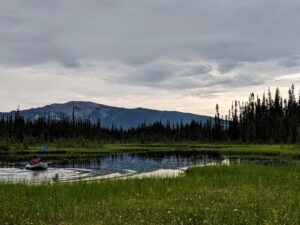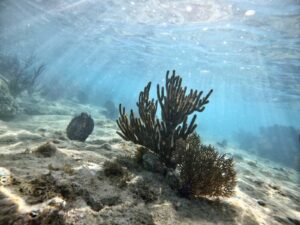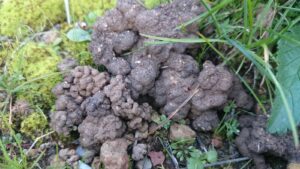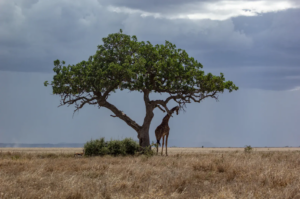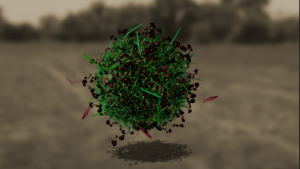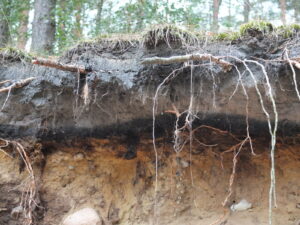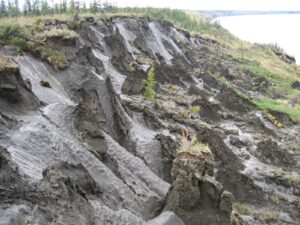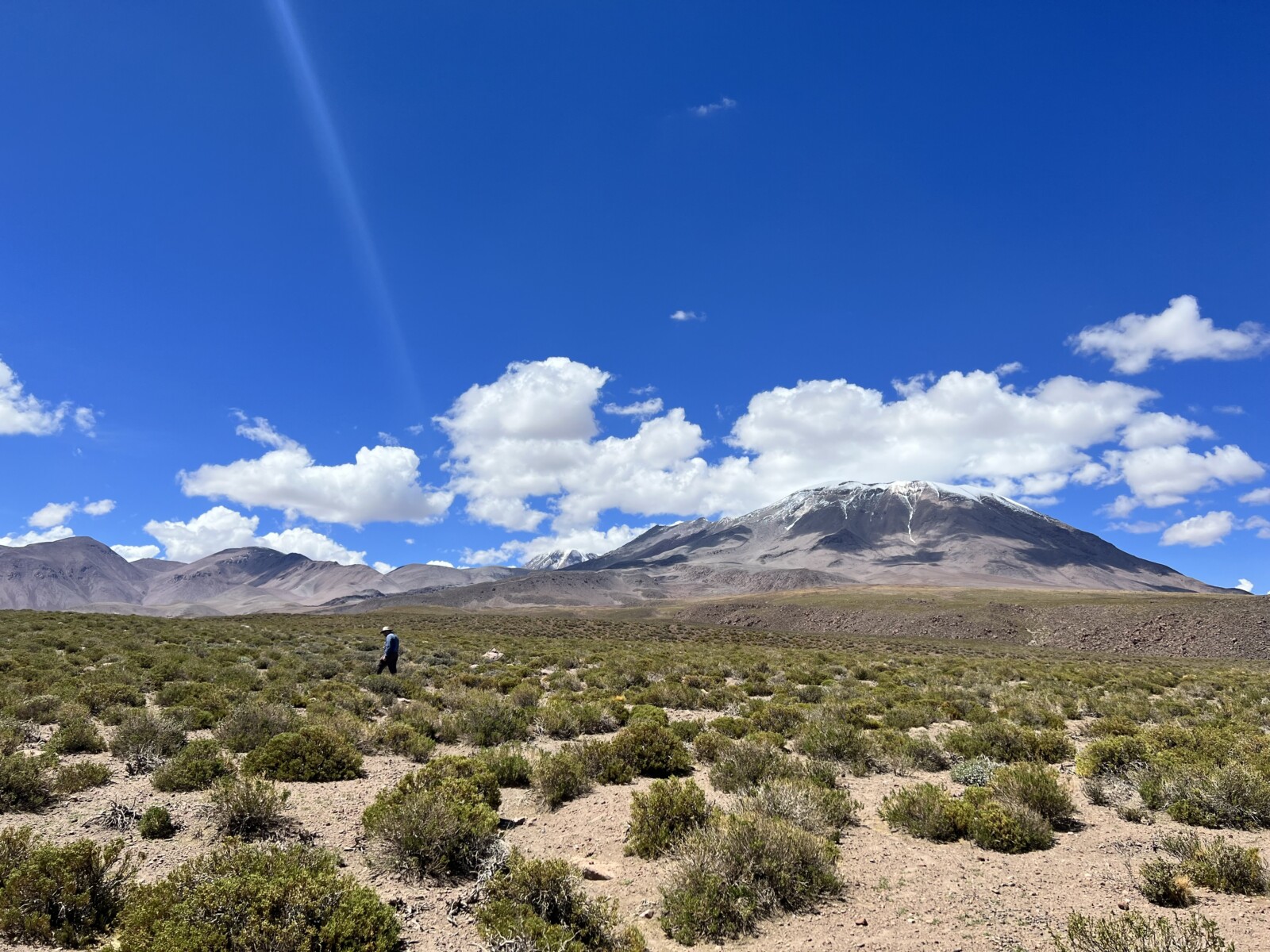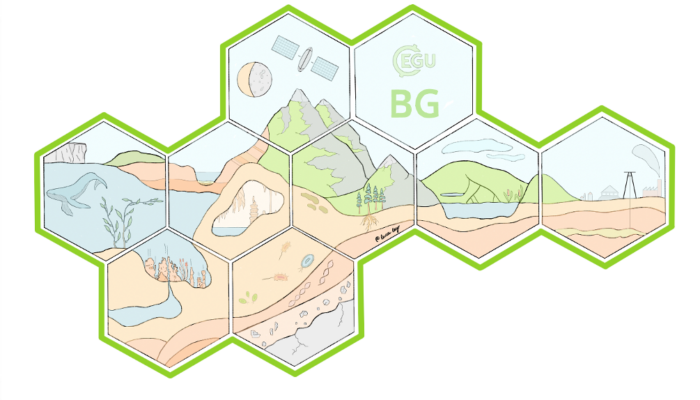
Spatial and temporal changes in environmental conditions over billions of years have driven the evolution of diverse microbial, fungal and plant species that have shaped the ecosystems, atmosphere and climate of our Earth system. Understanding the function and resilience of organisms and our biomes in response to climatic change and their complex feedbacks requires knowledge of its component parts and their interactions. Technological innovations in the measurement and interpretation of expansive and detailed ‘meta-omics’ datasets are poised to reveal mechanistic understanding across diverse organisms, scales and ‘spheres’ as well as facilitating a new generation of modelling tools to predict ecosystem function.
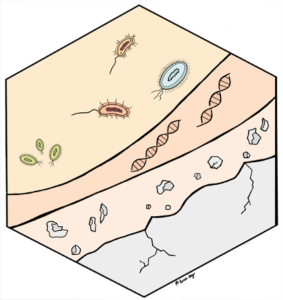
Artistic representation of the BG sub-division ‘Geomicrobiomes and their function’. Original artwork created by Lucia Layritz.
In this context the BG Division has recently created a new sub-division called ‘Geomicrobiomes and their function’. This year at the EGU 2024 held in Vienna the first special thematic BG session BG1.5 https://meetingorganizer.copernicus.org/EGU24/session/50581 will be held on Monday 15th April 14:00 – 18:00 CET gathering ecologists, biogeochemists and evolutionary biologists together to examine the -omic tool-boxes now available to characterise and interpret the form and function of organisms and communities, as well as the efforts now being made to integrate this knowledge across biological and temporal scales.
As this is a scientific topic at the interface between many disciplines we aim to start out in our first session to introduce the historical background to the development of the ‘omics’ approach particularly in the life sciences and subsequently explain some of the common terms and technical developments in this field of research. In this context we have invited a range of speakers to provide an overview of the field and how these techniques are being used to explore interesting ecosystems and global change questions.
EMERGE: Studying EMergent Ecosystem Responses to change through Genes-to-Ecosystems integration at the ‘model ecosystem’ of Stordalen Mire
Scott Saleska a Professor of Ecology and Evolutionary Biology at the University of Arizona will speak about some commonly used vocabulary when working with omics and present the ongoing work understanding multi-level responses of terrestrial peatlands that are being transformed by climate-change induced thawing of permafrost and changing the way microbes are cycling carbon. The talk will identify emergent principles of ecosystem responses to change via (i) analysis and scaling of long-term paired multi-omic and biogeochemical datasets capturing decade-scale responses to permafrost thaw, and (ii) integrating principles of genes-to-ecosystems (G2E) scaling with ecosystems-to-genes (E2G) feedbacks. This closed-loop genes-to-ecosystems-to-genes (G2E2G) framework relies on ‘the 3 As’ of biological response to change: Acclimation, Assembly, and Adaptation, each investigated through cutting-edge analytical and bioinformatic methods and scaled with a combination of remote sensing and modeling over various spatio-temporal datasets.
Exploring the ocean multiverse with Tara Oceans
Chris Bowler is research director at the CNRS and director of the Plant and Algae Genomics Laboratory at the Institut de biologie de l’École normale supérieure in Paris. The ocean is the largest ecosystem on Earth and yet we know very little about it. Ocean plankton form the base of marine food webs and are key players in Earth’s biogeochemical cycles but most of them are invisible to the naked eye and thus are largely uncharacterised. To increase our understanding of this underexplored world, a multidisciplinary consortium, Tara Oceans, was formed around the 36m research schooner Tara, which sampled plankton at more than 210 sites and multiple depth layers in all the major oceanic regions during expeditions from 2009-2013. In this session we will summarise the foundational resources from the project, which collectively represent the largest DNA sequencing effort for the oceans (see Science special issue May 22, 2015 and Cell, Nov 14, 2019), and analyses that illustrate several aspects of the Tara Oceans’ eco-systems biology approach to address microbial contributions to ecological and evolutionary processes. The project provides unique resources for several scientific disciplines that are foundational for mapping ocean biodiversity of a wide range of organisms that are rarely studied together, exploring their interactions, and integrating biology into our physico-chemical understanding of the ocean, as well as for identifying new organisms and genes of biotechnological interest. These resources, and the scientific innovations emerging to understand them, are furthermore critical towards developing baseline ecological context and predictive power needed to track the impact of climate change on the ocean.
Uncovering Biogeochemical Processes for a Comprehensive Understanding of Ecosystem Dynamics Using Integrative Multi-Omics
Linnea Honeker is a postdoctoral researcher at Lawrence Livermore National Laboratory, and will focus their contribution on soil biogeochemical processes within ecosystems that are complex and difficult to study. In particular with the advance of ‘omics’ technologies, it is
now possible to produce large datasets of biomolecule measurements (metabolites, lipids, proteins, genes, transcripts, etc.) across different scales. Each of these ‘omics’ datasets provide a different piece of a complex puzzle, therefore, when strategically combined, they can provide a more comprehensive understanding of underlying biogeochemical processes.
Towards an integrated program for tracking environmental change: the role of environmental genomics in trait-based interdisciplinary palaeoecology
Abraham Nqabutho Dabengwa is a Postdoctoral Researcher at the Evolutionary Studies Institute, University of the Witwatersrand, South Africa. He is a palaeoecologist working on understanding trait-based eco-evolutionary dynamics of vegetation, climate, and disturbances by fires and large herbivores in Southern African grasslands and savannas.
Global biodiversity loss threatens human wellbeing and future ecosystem functioning. Yet, observed historical changes to ecosystem functioning and species loss are non-random, with predictable winners and losers. Measurable physical, physiognomic, and physico-chemical adaptations or responses giving species abilities to survive and reproduce under specific conditions, i.e., functional traits, may help to explain and design strategies for managing environmental changes. Sedimentary-based palaeo-ecological reconstructions for tracking prehistorical changes comprise several disciplines and tools with parallel developments and/or stages of scientific maturity. In comparison, genomic approaches can simultaneously sample a wider range of biodiversity. In my presentation I explore with examples and potential scenarios, how old methods and new genomic tools in a multiple-proxy setting can advance trait-based analysis of biodiversity and ecosystem changes whereby traits serve as emergent properties for integrating disciplines.
Insight into the phylogeography of autotrophic carbon fixation in environmental microbiomes – an example of how we can leverage global metagenomic data to generate insights into biogeochemical pathways
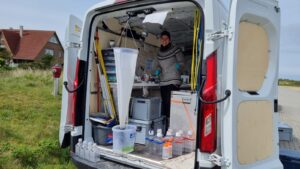
Sampling for EMBL’s current expedition along the European coastline (TRaversing European Coastlines, TREC). Anna is a member of the sampling team that collects aerosols, soil, sediment and sea water to study microbial communities in coastal environments and the interactions between biomes. She is responsible for the collection and processing of sea water samples. After collection, the samples are immediately taken to our mobil lab which was built into a camper van (see picture) where they get filtered and fixed for a variety of downstream analyses. Photo Credit: Joana Zukowska
Anna Mankowski is a marine microbiologist and bioinformatician working as a postdoctoral fellow at the European Molecular Biology Laboratory in Heidelberg, Germany. Anna specialises in studying autotrophic carbon fixation which plays a crucial role in the global carbon cycle as well as carbon sequestration and thus, also for managing the global climate crisis. Quantitatively the most important pathway during carbon fixation is the Calvin-Benson-Bassham cycle (CBB) which is, among others, used by phototrophic organisms such as plants, (micro-)algae and bacterioplankton. Besides the CBB cycle, six other metabolic pathways are currently known from prokaryotes. Recent studies suggest that these other prokaryotic pathways play a crucial role for global carbon cycling in diverse environments. However, despite the global importance of autotrophic carbon fixation, we still lack a comprehensive understanding of the geographic distribution, evolution and ecophysiology of the autotrophic prokaryotes
that carry it out, especially those that rely on other pathways than the CBB cycle. Many of these pathways for prokaryotic autotrophy are often known from individual organisms but their global as well as phylogenetic distribution remains largely unknown. This project aims to close this knowledge gap through a metagenomics-based approach that benefits from the increasing availability of metagenomic data covering the microbiomes of diverse and globally distributed ecosystems.
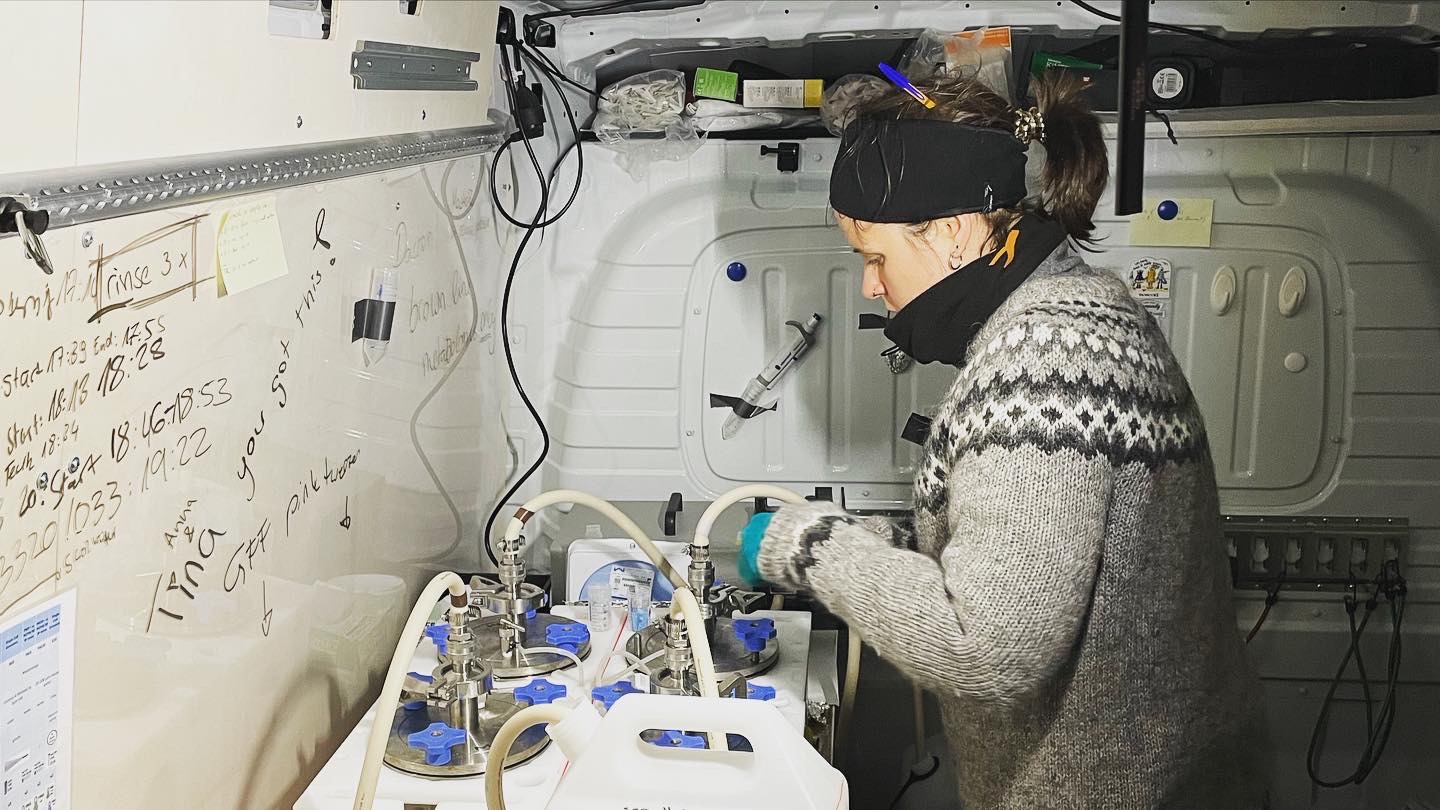
Setting up the tripod filtration unit where we collect different size fractions of plankton for metabarcoding, metagenomics, metatranscriptomis and metabolomics. Photo Credit: Tina Enders
Integrating omics data into soil trait-based models: Is genome size a potential master trait?
Luciana Chavez Rodriguez is a soil modeler working as a Postdoctoral Scholar at the University of California, Irvine, in the Department of Ecology and Evolutionary Biology. Luciana aims to predict soil biogeochemical processes using a refined representation of the soil microbial community in models. Traditional Monod-based models lump the complexity of the soil microbial community into one single pool. Empirical evidence, however, suggests that identifying who is there and what they do is essential to understanding and predicting changes in soil functions driven by microbial communities in the light of global change. Trait-based models can characterize different members of the soil community based on trait information and, thus, represent an avenue to explore how changes in environmental conditions affect microbial community assembly and the subsequent impact on soil biogeochemical processes. However, model parameters are commonly retrieved from physiological laboratory assays, which are limited to the culturable minority of soil microbiome taxa. In this context, omics data emerge as an alternative to estimate trait values for a larger portion of the soil microbiome. In this session we will present the progress being made in pipelines to generate emergent functional groups based on metagenome-assembled genomes (MAGs) from microbial communities using data from grassland and shrubland litter communities that show clear correlations between functional group genome sizes and trait parameters, indicating that model parameters can be potentially represented by genome size only, reducing model complexity and uncertainties related to model parameterization. These correlations may also extend to other environments, suggesting genome size as a potential master trait.
From omics to rates – Feeding the subsurface microbiome
Kirsten Kuesel is a Full Professor of Aquatic Geomicrobiology at the Friedrich Schiller University in Jena, Germany, and one of the founding directors of the German Centre for Integrative Biodiversity Research (iDiv). Kirsten researches the terrestrial subsurface that contains almost all of Earth’s freshwater reserves and hosts most of the planet’s total prokaryotic biomass. Studying the subsurface microbiome is challenging but a combination of special techniques including ‘omics’ tools and radiocarbon (14C) analyses of available C pools can shed light on ecological, metabolic, and trophic strategies that influence the development, temporal dynamics, and adaptations of groundwater microbes in carbonate rocks over time. This approach can reveal that sub-surface carbon fixation is fundamental to subsurface trophic webs, just as phototrophs are to marine biogeochemical cycling.
Microbial role in greenhouse gas cycling in subarctic soils and peatlands
Jenni Hultman is a senior scientist at the Natural Resources Institute Finland (LUKE). Jenni has been using ‘omics’ approaches to study microbes in cold environments, including permafrost, arctic soils, peatlands and sea ice. As changing climate leads to increased rates of soil organic matter decomposition in polar regions the overall impact on carbon and other biogeochemical cycles is difficult to predict without a deeper understanding of the soil microbial ecology. Jenni and colleagues have been collecting metagenomic and metatranscriptomic data from Arctic soils covering a range of ecosystems from dry upland tundra soils to water-logged fens and drained peat soils to search amongst their Metagenome-assembled genomes (MAGs) for genes involved in methane cycling and denitrification, an important process driving N2O emissions. Jenni shows that by coupling an in-depth characterisation of microbial communities with in-situ measurements of GHG fluxes, observed spatial patterns of GHG fluxes in the tundra and peat soils can be related to differences in the composition of microbial communities.
Concurrent ecological and evolutionary responses to environmental change influence carbon turnover in a soil microbiome
Alex Chase is a member of faculty at the Southern Methodist University in the Department of Earth Sciences, Texas, USA. Microorganisms are the driving force behind biogeochemical processes, yet the impact of rapid anthropogenic-induced environmental change on microbial responses and resulting ecosystem functions is not fully understood. Although microbial communities, or microbiomes, are commonly associated with ecological processes, their fast generation times and large population sizes also make them amenable to rapid adaptation to changing climate conditions. This work underscores the importance of considering both ecological and evolutionary responses, with a particular focus on the latter, to better understand the implications for biogeochemical cycles. By exploring the evolutionary dynamics of microbial communities, we aim to uncover how these organisms will adapt to environmental change and how their responses will affect biogeochemical processes on a larger scale. Through this research, we hope to deepen our understanding of the interconnectedness of microorganisms and the vital roles they play in maintaining the health of our planet.
Use of predictive metabolomics in plant ecology
Thomas Dussarrat is a postdoctoral researcher at the Bielefeld University, Germany. Metabolomics offers a comprehensive view of chemical traits that define the physiological state of an organism. Once combined with ecology and generalised linear models, the so-called predictive eco-metabolomics offers the possibility to understand and predict the responses of living organisms to environmental changes. Using untargeted metabolic analyses performed on multiple wild species from the Atacama Desert will be used to illustrate the potential outcomes of predictive metabolomics. First, multiplatform metabolomics was deployed on 24 Atacama plant species across an elevation gradient (2,500 to 4,500 m.a.s.l) to unveil a generic toolbox involved in plant resilience to harsh climates2. Second, ecology and predictive metabolomics were combined to test (i) the influence of the nurse effect (plant-plant positive interactions) of Marhueniopsis camachoi on Atacama plant communities and (ii) its metabolic consequences on the protected species3. Results placed this cactus species as a key drive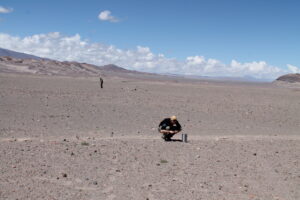 r of Atacama plant communities and highlighted changes in protected species that reshaped their metabolic strategy to cope with extreme conditions. Overall, our findings illustrate the excellent capacity of this approach to identify chemical traits for resilience to environmental threats and to investigate ecological processes. Understanding chemical mechanisms that govern plant response to (a)biotic threats and the dynamics of plant communities is key to developing more accurate and realistic ecological models, and therefore predicting in response to climate change.
r of Atacama plant communities and highlighted changes in protected species that reshaped their metabolic strategy to cope with extreme conditions. Overall, our findings illustrate the excellent capacity of this approach to identify chemical traits for resilience to environmental threats and to investigate ecological processes. Understanding chemical mechanisms that govern plant response to (a)biotic threats and the dynamics of plant communities is key to developing more accurate and realistic ecological models, and therefore predicting in response to climate change.
Integrating multi-omic and isotopic approaches to identify plant-microbe interactions driving N2O emissions from agricultural soil
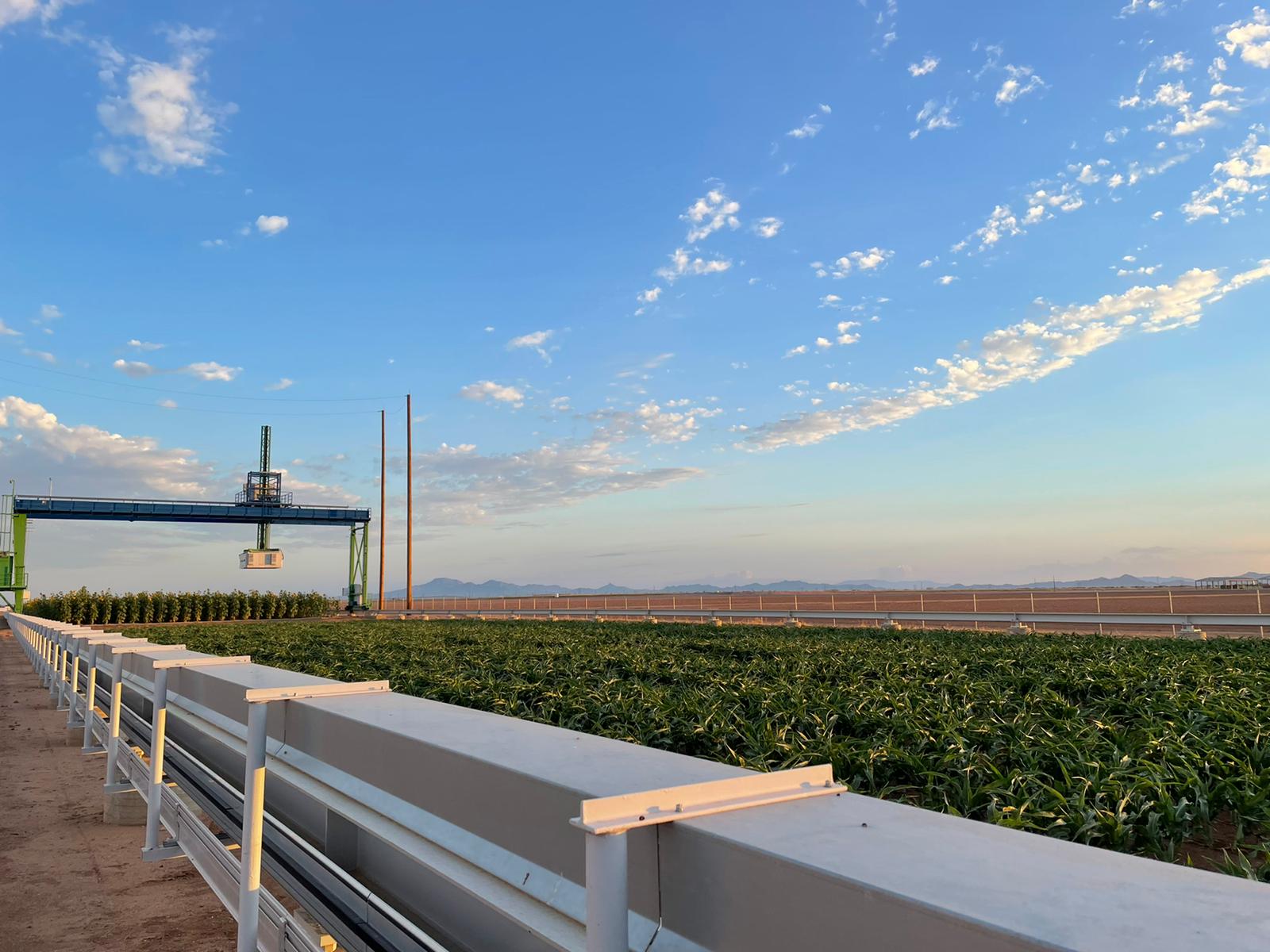 Laura Meredith is an Associate Professor of Ecosystem Genomics at the University of Arizona, USA. Plant-microbe interactions drive nitrogen (N) transformations in soil, and a detailed understanding of these inter-organismal interactions is needed to enhance crop productivity and N use efficiency, and to minimize N losses including as nitrous oxide (N2O) to the atmosphere. Greater understanding is needed of the microbial taxa and metabolic pathways responsible for the production of N2O in soil and the strength with which they compete with plant roots to assimilate and metabolize applied ammonium (NH4+) and/or nitrate (NO3-) fertilizers. Across different sorghum genotypes that differ in biomass productivity, we combined ‘omics approaches and subsurface trace gas measurements with pulse-chase 15N isotope labeling to answer the following questions: 1) How is applied N allocated within the mature sorghum rhizosphere? and 2) Which soil taxa and metabolic pathways are responsible for conversion of this applied N to N2O? Using these methods, we aim to identify the primary microbes and genetic elements involved in N transformations in an semiarid agroecosystem.
Laura Meredith is an Associate Professor of Ecosystem Genomics at the University of Arizona, USA. Plant-microbe interactions drive nitrogen (N) transformations in soil, and a detailed understanding of these inter-organismal interactions is needed to enhance crop productivity and N use efficiency, and to minimize N losses including as nitrous oxide (N2O) to the atmosphere. Greater understanding is needed of the microbial taxa and metabolic pathways responsible for the production of N2O in soil and the strength with which they compete with plant roots to assimilate and metabolize applied ammonium (NH4+) and/or nitrate (NO3-) fertilizers. Across different sorghum genotypes that differ in biomass productivity, we combined ‘omics approaches and subsurface trace gas measurements with pulse-chase 15N isotope labeling to answer the following questions: 1) How is applied N allocated within the mature sorghum rhizosphere? and 2) Which soil taxa and metabolic pathways are responsible for conversion of this applied N to N2O? Using these methods, we aim to identify the primary microbes and genetic elements involved in N transformations in an semiarid agroecosystem.
Assessing the aeromicrobiome through omics
Pierre Amato is a researcher at the CNRS, Clermont-Ferrand, France. The atmosphere carries a wide variety of micro-organisms emitted by surfaces, with residence times of up to a few days. While suspended in the air, micro-organisms are exposed to harsh conditions of water limitation, oxidants, low temperatures and lack of nutrients, which can severely compromise their survival and imply strong metabolic modulations. Clouds, by offering condensed water and dissolved nutrients to living cells likely promote biological processes in an otherwise vast and hostile desert. These can interact with the complex chemical processes occurring in clouds (i.e. carbon degradation, oxidant chemistry, etc.) through metabolic activity, and participate to nucleation processes (i.e. water condensation and ice formation) as particles with specific surface properties. Studying airborne microorganisms is highly challenging due to ultra-low and spread biomass, limited residence time, and great spatial and temporal variabilities at short scales. Specific methodologies had thus to be developed in order to capture the diversity and functioning of living microorganisms along their atmospheric life cycle, decipher their drivers, and assess their implication in biogeochemical cycles.
By combining eco-evolutionary knowledge with ecosystem-level concepts of community traits and resilience we hope to develop and encourage future BG sessions that use integrated ‘omics’ and ‘meta-omics’ approaches with other biogeoscience techniques to provide a deeper mechanistic understanding of our ecosystems.

